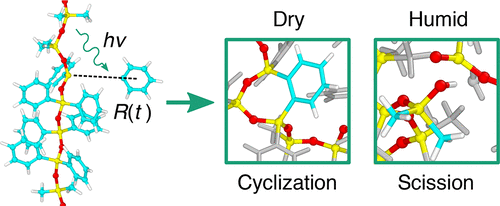当前位置:
X-MOL 学术
›
J. Phys. Chem. B
›
论文详情
Our official English website, www.x-mol.net, welcomes your
feedback! (Note: you will need to create a separate account there.)
Chemical Degradation Pathways in Siloxane Polymers Following Phenyl Excitations
The Journal of Physical Chemistry B ( IF 2.8 ) Pub Date : 2018-12-07 , DOI: 10.1021/acs.jpcb.8b09636 Matthew P. Kroonblawd 1 , Nir Goldman 1, 2 , James P. Lewicki 1
The Journal of Physical Chemistry B ( IF 2.8 ) Pub Date : 2018-12-07 , DOI: 10.1021/acs.jpcb.8b09636 Matthew P. Kroonblawd 1 , Nir Goldman 1, 2 , James P. Lewicki 1
Affiliation

|
We use ensembles of quantum-based molecular dynamics simulations to predict the chemical reactions that follow radiation-induced excitations of phenyl groups in a model copolymer of polydimethylsiloxane and polydiphenylsiloxane. Our simulations span a wide range of highly porous and condensed phase densities and include both wet and dry conditions. We observe that in the absence of water, excited phenyl groups tend to abstract hydrogen from other methyl or phenyl side groups to produce benzene, with the under-hydrogenated group initiating subsequent intrachain cyclization reactions. These systems also yield minor products of diphenyl moieties formed by the complete abstraction of both phenyl groups from a single polydiphenylsiloxane subunit. In contrast, we find that the presence of water promotes the formation of free benzene and silanol side groups, reduces the likelihood for intrachain cyclization reactions, and completely suppresses the formation of diphenyl species. In addition, we predict that water plays a critical role in chain scission reactions, which indicates a possible synergistic effect between environmental moisture and radiation that could promote alterations of a larger polymer network. These results could have impact in interpreting accelerated aging experiments, where polymer decomposition reactions and network rearrangements are thought to have a significant effect on the ensuing mechanical properties.
中文翻译:

苯基激发后硅氧烷聚合物中的化学降解途径
我们使用基于量子的分子动力学模拟集成来预测在聚二甲基硅氧烷和聚二苯基硅氧烷的模型共聚物中辐射诱导的苯基激发之后的化学反应。我们的模拟涵盖了范围广泛的高度多孔和凝结的相密度,并且包括潮湿和干燥条件。我们观察到,在没有水的情况下,受激发的苯基往往会从其他甲基或苯基侧基中提取氢以生成苯,而氢化不足的基团会引发随后的链内环化反应。这些体系还产生了由单个聚二苯基硅氧烷亚基完全提取两个苯基而形成的二苯基部分的次要产物。相比之下,我们发现水的存在促进了游离苯和硅烷醇侧基的形成,降低了链内环化反应的可能性,并完全抑制了二苯基物质的形成。此外,我们预测水在断链反应中起关键作用,这表明环境水分和辐射之间可能存在协同作用,可能促进更大的聚合物网络的变化。这些结果可能会对解释加速老化实验产生影响,在该实验中,聚合物分解反应和网络重排被认为对随后的机械性能产生重大影响。我们预测水在断链反应中起关键作用,这表明环境水分和辐射之间可能存在协同作用,可能促进更大的聚合物网络的变化。这些结果可能会对解释加速老化实验产生影响,在该实验中,聚合物分解反应和网络重排被认为对随后的机械性能产生重大影响。我们预测水在断链反应中起关键作用,这表明环境水分和辐射之间可能存在协同作用,可能促进更大的聚合物网络的变化。这些结果可能会对解释加速老化实验产生影响,在该实验中,聚合物分解反应和网络重排被认为对随后的机械性能产生重大影响。
更新日期:2018-12-08
中文翻译:

苯基激发后硅氧烷聚合物中的化学降解途径
我们使用基于量子的分子动力学模拟集成来预测在聚二甲基硅氧烷和聚二苯基硅氧烷的模型共聚物中辐射诱导的苯基激发之后的化学反应。我们的模拟涵盖了范围广泛的高度多孔和凝结的相密度,并且包括潮湿和干燥条件。我们观察到,在没有水的情况下,受激发的苯基往往会从其他甲基或苯基侧基中提取氢以生成苯,而氢化不足的基团会引发随后的链内环化反应。这些体系还产生了由单个聚二苯基硅氧烷亚基完全提取两个苯基而形成的二苯基部分的次要产物。相比之下,我们发现水的存在促进了游离苯和硅烷醇侧基的形成,降低了链内环化反应的可能性,并完全抑制了二苯基物质的形成。此外,我们预测水在断链反应中起关键作用,这表明环境水分和辐射之间可能存在协同作用,可能促进更大的聚合物网络的变化。这些结果可能会对解释加速老化实验产生影响,在该实验中,聚合物分解反应和网络重排被认为对随后的机械性能产生重大影响。我们预测水在断链反应中起关键作用,这表明环境水分和辐射之间可能存在协同作用,可能促进更大的聚合物网络的变化。这些结果可能会对解释加速老化实验产生影响,在该实验中,聚合物分解反应和网络重排被认为对随后的机械性能产生重大影响。我们预测水在断链反应中起关键作用,这表明环境水分和辐射之间可能存在协同作用,可能促进更大的聚合物网络的变化。这些结果可能会对解释加速老化实验产生影响,在该实验中,聚合物分解反应和网络重排被认为对随后的机械性能产生重大影响。

































 京公网安备 11010802027423号
京公网安备 11010802027423号